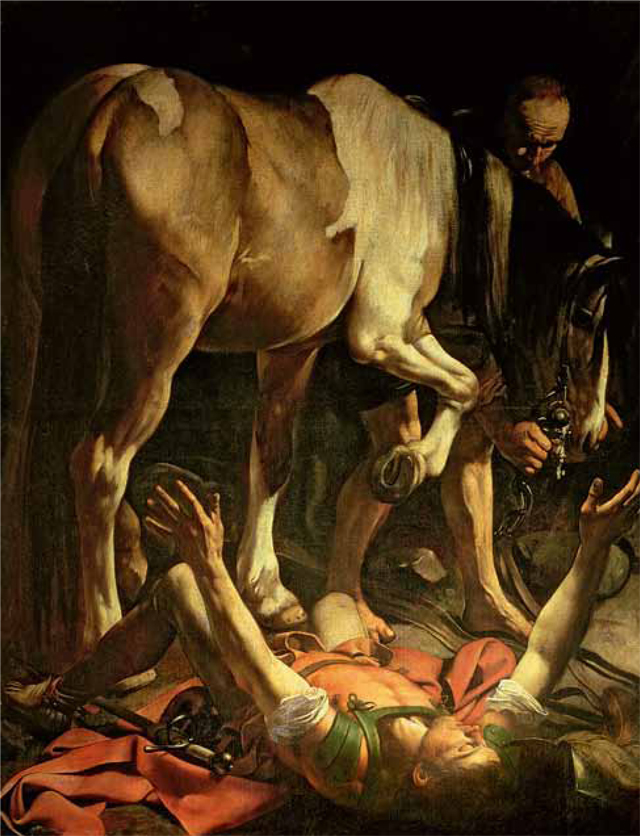My Favourite Painting: Sebastian Faulks
Sebastian Faulks chooses his favourite painting for Country Life.


The Conversion of St Paul on the Road to Damascus, 1601, by Michelangelo Merisi da Caravaggio (1571–1610), 901/2in by 69in, S. Maria del Popolo, Rome. Bridgeman Images.
Sebastian Faulks says: 'I like it because a) you have to put money in the slot to see it, and b) it’s the best picture ever of a horse’s bottom.'
Sebastian Faulks is a British novelist, journalist and broadcaster. His latest novel is A Possible Life.
Art critic John McEwen comments: 'It’s easy to forget how much the future St Paul loathed Christians before his miraculous conversion to Christianity on the road to Damascus. As the young firebrand Saul of Tarsus, he had presided at the stoning of Stephen, the first Christian martyr. And, ‘breathing out threatenings and slaughter against the disciples of the Lord’, he had left for Damascus, with official licence to arrest any Christians, ‘whether they were men or women’, and to bring them back to Jerusalem. Then, ‘suddenly there shined round about him a light from heaven: And he fell to the earth, and heard a voice saying unto him, Saul, Saul, why persecutest thou me?
Caravaggio made a first attempt at the subject before this masterpiece. The earlier version, (Odescalchi Balbi Collection, Rome), has many beautiful and typical passages, but it’s a jumble. There is too much to catch the eye, with three other figures and a rearing horse vying for attention. Even a cloud-streaked sky plays a part.
In the second version, the blinded Saul’s outspread arms make him the climactic apex of the drama and the light is the more miraculous for beaming out of impenetrable darkness. The event is not tumultuously public, but eerily still and private. This shift to a formally more pared and powerful style occurred between the autumn of 1600 and 1601. It marks the onset of Caravaggio’s artistic maturity, as does its companion piece in the same side chapel, The Crucifixion of St Peter.'
This article was first published in Country Life, August 14, 2013
Sign up for the Country Life Newsletter
Exquisite houses, the beauty of Nature, and how to get the most from your life, straight to your inbox.
Country Life is unlike any other magazine: the only glossy weekly on the newsstand and the only magazine that has been guest-edited by HRH The King not once, but twice. It is a celebration of modern rural life and all its diverse joys and pleasures — that was first published in Queen Victoria's Diamond Jubilee year. Our eclectic mixture of witty and informative content — from the most up-to-date property news and commentary and a coveted glimpse inside some of the UK's best houses and gardens, to gardening, the arts and interior design, written by experts in their field — still cannot be found in print or online, anywhere else.
-
 380 acres and 90 bedrooms on the £25m private island being sold by one of Britain's top music producers
380 acres and 90 bedrooms on the £25m private island being sold by one of Britain's top music producersStormzy, Rihanna and the Rolling Stones are just a part of the story at Osea Island, a dot on the map in the seas off Essex.
By Lotte Brundle
-
 'A delicious chance to step back in time and bask in the best of Britain': An insider's guide to The Season
'A delicious chance to step back in time and bask in the best of Britain': An insider's guide to The SeasonHere's how to navigate this summer's top events in style, from those who know best.
By Madeleine Silver
-
 My favourite painting: Allan Mallinson
My favourite painting: Allan MallinsonMilitary historian Allan Mallinson picks an image of 'faith, generosity and ultimate sacrifice'.
By Charlotte Mullins
-
 My Favourite Painting: Piet Oudolf
My Favourite Painting: Piet Oudolf'One cannot sense whether he is far out on the ocean or closer to shore, or what he may be watching or feeling in that moment as he stares towards the beach.’
By Country Life
-
 My Favourite Painting: Mary Plazas
My Favourite Painting: Mary Plazas'There is compassion, awe, humility, a knowing yet a questioning in the glistening eyes. It moves me, it inspires me beyond the need to know.’
By Country Life
-
 My favourite painting: Robert Kime
My favourite painting: Robert KimeRobert Kime shares his fondness for New Year Snow by Ravilious
By Country Life
-
 My Favourite Painting: Anna Pavord
My Favourite Painting: Anna PavordAnna Pavord chooses a picture which reminds her of where she grew up
By Country Life
-
 My favourite painting: The Duchess of Wellington
My favourite painting: The Duchess of WellingtonThe Duchess of Wellington chooses her favourite painting for Country Life.
By Country Life
-
 My favourite painting: Maureen Lipman
My favourite painting: Maureen LipmanMaureen Lipman chooses her favourite painting for Country Life.
By Country Life
-
 My favourite painting: Jacqueline Wilson
My favourite painting: Jacqueline Wilson'I looked at this painting and decided to write about a Victorian circus girl one day'
By Country Life